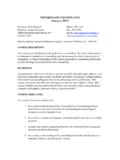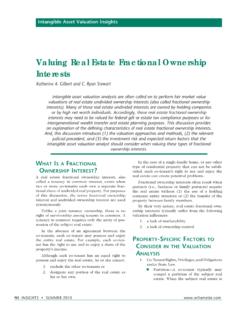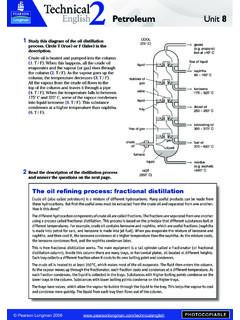Transcription of FACTORIAL AND FRACTIONAL FACTORIAL DESIGNS WITH ...
1 FACTORIAL AND FRACTIONAL FACTORIAL DESIGNSWITH randomization restrictions - A projective geometric APPROACHbyPritam , Indian Statistical Institute, , Indian Statistical Institute, 2003a thesis submitted in partial fulfillmentof the requirements for the degree ofDoctor of Philosophyin the DepartmentofStatistics and Actuarial Sciencec Pritam Ranjan 2007 SIMON FRASER UNIVERSITYS ummer 2007 All rights reserved. This work may not bereproduced in whole or in part, by photocopyor other means, without the permission of the :Pritam RanjanDegree:Doctor of PhilosophyTitle of thesis: FACTORIAL and FRACTIONAL FACTORIAL DESIGNS with Ran-domization restrictions - A projective geometric Ap-proachExamining Committee:Dr.
2 Richard LockhartChairDr. Derek Bingham, Senior SupervisorDr. Randy Sitter, SupervisorDr. Boxin Tang, SupervisorDr. Tom Loughin, SFU ExaminerDr. Kenny Ye, External Examiner,Albert Einstein College of MedicineDate Approved:iiAbstractTwo-level FACTORIAL and FRACTIONAL FACTORIAL DESIGNS have played a prominent role inthe theory and practice of experimental design . Though commonly used in industrialexperiments to identify the significant effects, it is often undesirable to perform thetrials of a FACTORIAL design (or, FRACTIONAL FACTORIAL design ) in a completely randomorder. Instead, restrictions are imposed on the randomization of experimental recent years, considerable attention has been devoted to FACTORIAL and fractionalfactorial plans with different randomization restrictions ( , nested DESIGNS , split-plotdesigns, split-split-plot DESIGNS , strip-plot DESIGNS , split-lot DESIGNS , and combinationsthereof).
3 Bingham et al. (2006) proposed an approach to represent the randomizationstructure of FACTORIAL DESIGNS with randomization restrictions . This thesis introducesa related, but more general, representation referred to asrandomization defining con-trast subspaces(RDCSS). The RDCSS is a projective geometric formulation ofran-domization defining contrast subgroups(RDCSG) defined in Bingham et al. (2006)and allows for theoretical FACTORIAL DESIGNS with different randomization structures, the mere existenceof a design is not straightforward. Here, the theoretical results are developed forthe existence of FACTORIAL DESIGNS with randomization restrictions within this unifiedframework.
4 Our theory brings together results from finite projective geometry toestablish the existence and construction of such DESIGNS . Specifically, for the existenceof a set of disjoint RDCSSs, several results are proposed using (t 1)-spreads andiiipartial (t 1)-spreads ofPG(p 1,2). Furthermore, the theory developed here offers asystematic approach for the construction of two-level full FACTORIAL DESIGNS and regularfractional FACTORIAL DESIGNS with randomization , when the conditions for the existence of a set of disjoint RDCSSs are vio-lated, the data analysis is highly influenced from the overlapping pattern among theRDCSSs. Under these circumstances, a geometric structure calledstaris proposedfor a set of (t 1)-dimensional subspaces ofPG(p 1, q), where 1< t < p.
5 Thisexperimental plan permits the assessment of a relatively larger number of factorialeffects. The necessary and sufficient conditions for the existence of stars and a collec-tion of stars are also developed here. In particular, stars constitute useful DESIGNS forpractitioners because of their flexible structure and easy my teachers, parents and are many people who deserve thanks for helping me in many different ways topursue my career in academics. The last four years in this department has been anenjoyable and unforgettable experience for and foremost, I cannot thank enough to my senior supervisor, Dr. DerekBingham, for his support, guidance and encouragement in every possible way.
6 Inparticular, I will always be grateful to him for his friendship. Many thanks to mycommittee members, Dr. Kenny Ye, Dr. Tom Loughin, Dr. Boxin Tang and Sitter for their useful comments and suggestions that led to significant im-provement in the thesis. I would thank Dr. Petr Lisonek for his help on getting mestarted in the area of projective course, the graduate students of this department play a very important rolein making my stay in this department really wonderful. Special thanks to Chunfang,Crystal and Matt for their friendship. They were there for me whenever I neededthem. I would also like to thank Soumik Pal and Abhyuday Mandal, my friends fromIndian Statistical Institute, for their support and encouragement which motivated meto do I would not be here without their help and , and most importantly, I would like to thank my parents and sisters fortheir support and the sacrifices they made throughout the course of my of TablesixList of Figuresxi1 Introduction12 Preliminaries and FACTORIAL and FRACTIONAL FACTORIAL DESIGNS .
7 FRACTIONAL FACTORIAL DESIGNS .. FACTORIAL and FRACTIONAL FACTORIAL DESIGNS with randomization Block DESIGNS .. Split-plot DESIGNS .. Strip-plot DESIGNS .. Split-lot DESIGNS .. Finite projective geometric representation .. randomization restrictions and subspaces ..263 Linear Regression Model and Unified Model .. Motivation for disjoint RDCSSs ..384 FACTORIAL DESIGNS and Disjoint Existence of RDCSSs .. RDCSSs and (t 1)-spreads .. RDCSSs and disjoint subspaces .. Construction of Disjoint Subspaces .. RDCSSs and (t 1)-spreads .. Partial (t 1)-spreads .. Disjoint subspaces of different sizes .. FRACTIONAL FACTORIAL DESIGNS .
8 Further applications ..665 FACTORIAL DESIGNS and Minimum overlap .. Overlapping strategy .. Stars .. Balanced stars and minimal (t 1)-covers .. Finite galaxies .. Discussion ..996 Summary and Future Work101 Bibliography106viiiList of FACTORIAL effect estimates for the chemical experiment.. The arrangement of 64 experimental units in 4 blocks.. The analysis of variance table for a split-plot design .. The analysis of variance table for a strip-plot design .. A design matrix for a 24full FACTORIAL experiment.. The analysis of variance table for the 23split-lot example.. The ANOVA table for the 25split-lot design in a two-stage process.
9 The elements ofPusing cyclic construction.. The 2-spread obtained using the cyclic construction.. The 3-spreadS obtained after applyingM0onS .. The ANOVA table for the 27full FACTORIAL design .. The 2-spread ofPG(5,2) after transformation.. The 2-spread ofPG(5,2) after applying the collineation matrixM.. The ANOVA table for the battery cell experiment.. The grouping of FACTORIAL effects for the battery cell experiment.. The ANOVA table for the chemical experiment.. The grouping of effects for the chemical experiment.. The ANOVA table for the 220 13split-lot design in a 18-stage The distribution of FACTORIAL effects for the battery cell experiment.
10 The ANOVA table for the plutonium alloy experiment.. The sets of effects having equal variance in the 25split-lot design .. The ANOVA table for the battery cell experiment.. The elements ofSusing cyclic construction.. The elements of the relabelled spread..89xList of The half-normal plot for the 15 FACTORIAL effects.. The split-plot design configuration.. The row-column design arrangement.. A split-lot design structure for a three-stage process.. The Fano plane.. A collineation ofPG(2,2).. A homogeneous finite galaxyG(9,2,1) inPG(5,2).. Balanced stars; The numbers{1,3,4,6,7,8}represent the number ofeffects in the rays and the common overlap.









